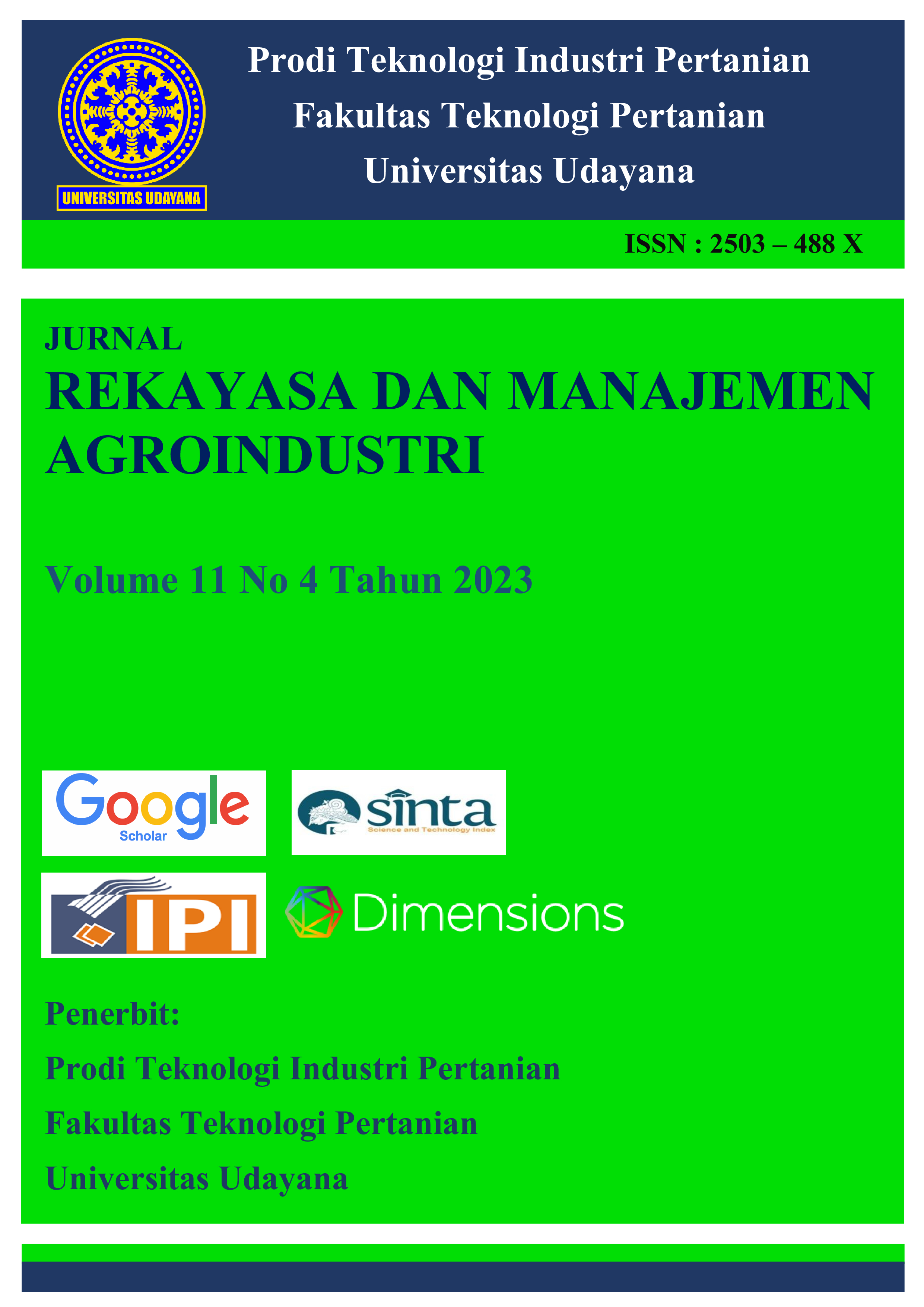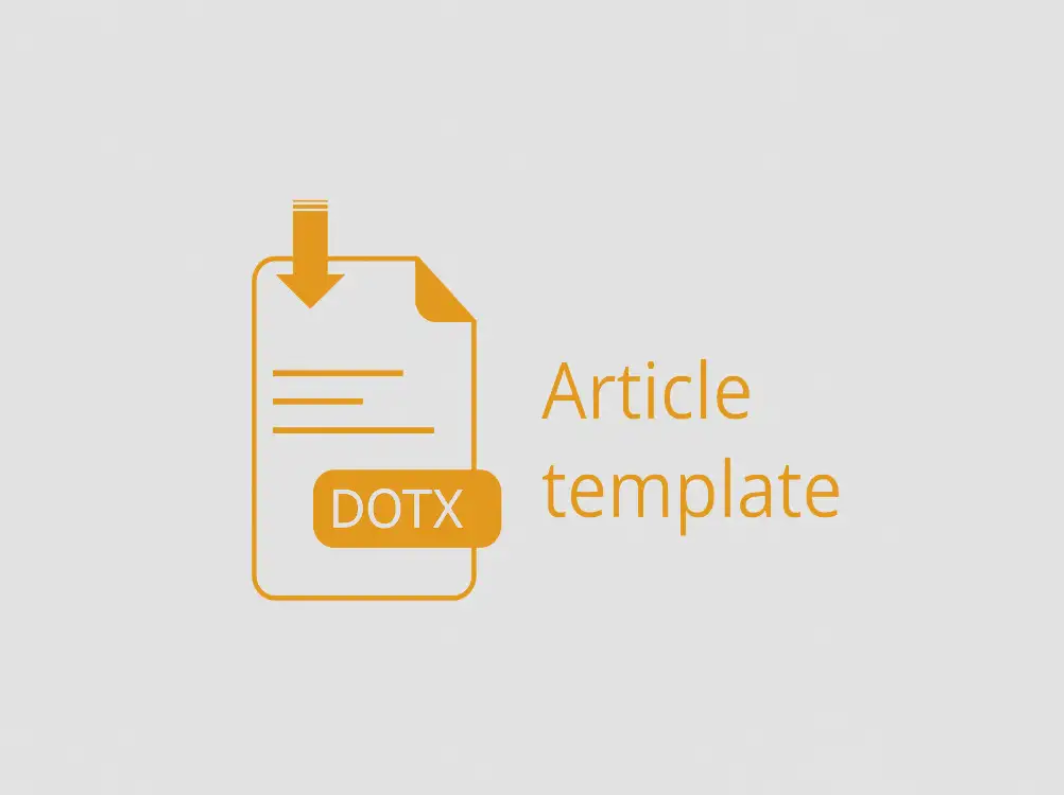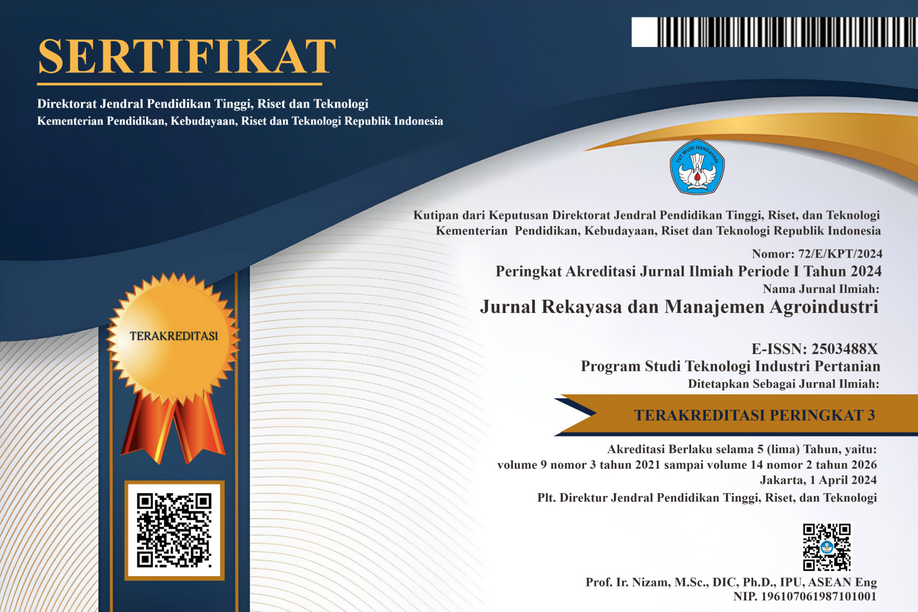Aktivitas Antioksidan Ekstrak Kulit Buah Kakao Hasil Ekstraksi Menggunakan Metode Microwave Assisted Extraction Pada Variasi Waktu Dan Daya
Abstract
The processing of cocoa produce by-product 70-75% of the cocoa pod husk. Cocoa pod husk contains phenol compounds that have the potential to be a source of natural antioxidants that can be obtained through the extraction process. One of the extraction methods that can be used is the Microwave Assisted Extraction (MAE) method. This research was conducted to determine the effect to time and extraction power using Microwave Assisted Extraction (MAE) on the characteristics of cocoa pod husk extract and to obtain the best combination time and extraction power using Microwave Assisted Extraction (MAE) that can produce cocoa pod husk extract as a source of antioxidants. The experimental design used in this research was a factorial randomized block design, which are grouped into 2 groups based on the implementation time and consisted of two factors. The first factor was the time of extractions which consisted of 5 level that namely 2, 4, 6, 8, and 10 minutes. The second factor was the power of extraction which consisted of 2 level namely 450 and 600 watt. The data were analyzed by analysis of variance and continued with Tukey test. The result showed that the time and extraction power using Microwave Assisted Extraction (MAE) and their interactions had a very significant effect on yield, total phenol, total flavonoid and antioxidant capacity of cocoa pod husk extract. From the index effectiveness test, the best treatment was extraction by time 6 minutes and power 600 watt with characteristic yield was 8,36 ± 0,06%, total phenol was 41,29 ± 0,40 mg GAE/g extract, total flavonoid was 36,97 ± 0,30 mg QE/g extract, antioxidant capacity was 16,33 ± 0,27 mg GAEAC/g extract.
Keywords : Time extraction, power extraction, antioxidants, extraction, cocoa pod husk
Proses pengolahan buah kakao menghasilkan hasil samping kulit buah kakao sebesar 70-75%. Kulit buah kakao mengandung senyawa fenol yang berpotensi sebagai sumber antioksidan alami yang dapat diperoleh melalui proses ekstraksi. Salah satu metode ekstraksi yang dapat digunakan adalah dengan menggunakan metode Microwave Assisted Extraction (MAE). Penelitian ini dilakukan untuk mengetahui pengaruh waktu dan daya pada ekstraksi menggunakan metode Microwave Assisted Extraction (MAE) terhadap karakteristik ekstrak kulit buah kakao serta menentukan kombinasi perlakuan waktu dan daya pada ekstraksi menggunakan metode Microwave Assisted Extraction (MAE) terbaik yang dapat menghasilkan ekstrak kulit buah kakao sebagai sumber antioksidan. Rancangan percobaan yang digunakan dalam penelitian ini adalah Rancangan Acak Kelompok faktorial yang dikelompokkan menjadi 2 kelompok berdasarkan waktu pelaksanaan dan terdiri dari dua faktor. Faktor pertama adalah waktu ekstraksi yang terdiri dari 5 taraf yaitu 2, 4, 6, 8 dan 10 menit. Faktor kedua adalah daya ekstraksi yang terdiri dari 2 taraf yaitu 450 dan 600 watt. Data dianalisis dengan analisis varian dan dilanjutkan dengan uji BNJ. Hasil penelitian menunjukkan bahwa waktu dan daya pada ekstraksi menggunakan metode Microwave Assisted Extraction (MAE) serta interaksinya berpengaruh sangat nyata terhadap rendemen, total fenol, total flavonoid dan kapasitas antioksidan. Dari uji indeks efektivitas diperoleh perlakuan terbaik adalah ekstraksi dengan waktu 6 menit dan daya 600 watt dengan karakteristik rendemen sebesar 8,36 ± 0,06%, total fenol sebesar 41,29 ± 0,40 mg GAE/g, total flavonoid sebesar 36,97 ± 0,30 mg QE/g dan kapasitas antioksidan sebesar 16,33 ± 0,27 mg GAEAC/g ekstrak.
Kata kunci : Waktu ekstraksi, daya ekstraksi, antioksidan, ekstraksi, kulit buah kakao
Downloads
References
Al-Farsi, M., Alasalvar, C., Al-Abid, M., Al-Shoaily, K., Al-Amry, M. dan Al-Rawahy, F. 2007. Compositional and functional characteristics of dates, syrups, and their by-products. Food Chemistry, 104(3), 943-947. https://doi.org/10.1016/j.foodchem.2006.12.051
Badan Pusat Statistik. 2022. Statistik Kakao Indonesia 2021. Badan Pusat Statistik Indonesia. Jakarta.
Blois, M. S. 1958. Antioxidant determinations by the use of a stable free radical. Nature, 181, 1199-1200. http://dx.doi.org/10.1038/1811199a0.
Budiyanto, A., dan Yulianingsih. 2008. Pengaruh suhu dan waktu ekstraksi terhadap karakter pektin dari ampas jeruk siam (Citrus nobilis L.). Jurnal Pascapanen, 5(2), 37-44. http://dx.doi.org/10.21082/jpasca.v5n2.2008.37-44.
Chang, C., Yang, M., Wen, H., dan Chern, J. 2002. Estimation of total flavonoid content in propolis by two complementary colorimetric methods. Journal of Food Drug Analysis, 10, 178-182.
Cruz, G., Pirilä, M., Huuhtanen, M., Carrión, L., Alvarenga, E., dan Keiski, R. L. 2012. Production of activated carbon from cocoa (Theobroma cacao L.) pod husk. Journal Civil and Environmental Engineering, 2(2), 1-6. http://dx.doi.org/10.4172/2165-784X.1000109.
De Garmo, E. P., Sullivan, W. G., dan Canada, C. R. 1984. Engineering economy. Macmillan Publisher. New York.
Gala, S, Kusuma, H. S., Sudrajat, R. G. M., Susanto, D. F., dan Mahfud. 2016. Ekstraksi bahan pewarna alami dari kayu mahoni (Swietenia mahagoni) menggunakan metode MAE (microwave assisted extraction). Jurnal Teknik Kimia. 11(1):7-13.
Garofulić, I. E., Dragović-Uzelac, V., Jambrak, A. R., dan Jukić, M. 2013. The effect of microwave assisted extraction on the isolation of anthocyanins and phenolic acids from sour cherry Marasca (Prunus cerasus var. Marasca). Journal of Food Engineering, 117(4), 437–442. https://doi.org/10.1016/j.jfoodeng.2012.12.043
Hidayat, P. A. N. P., Puspawati, G. A. K. D., dan Yusasrini, N. L. A. 2022. Pengaruh waktu dan daya microwave pada metode Microwave Assisted Axtraction (MAE) terhadap aktivitas antioksidan dan pigmen ekstrak daun ubi kayu (Manihot utilissima pohl.). Jurnal Ilmu dan Teknologi Pangan, 11(1), 134-146. https://doi.org/10.24843/itepa.2022.v11.i01.p14.
Ibrahim, D. S., dan El-Maksoud, M. A. E. A. 2015. Effect of strawberry (Fragaria× ananassa) leaf extract on diabetic nephropathy in rats. International Journal of Experimental Pathology. 96(2):87-93. https://doi:10.1111/iep.12116
ICCO. 2022. Quarterly bulletin of cocoa statistics. The International Cocoa Organization. United Kingdom.
Kristanti, Y., Widarta, I. W., dan Permana, I. D. G. M. 2019. Pengaruh waktu dan konsentrasi etanol menggunakan metode Microwave Asissted Extraction (MAE) terhadap aktivitas antioksidan ekstrak rambut jagung (Zea mays L.). Jurnal Ilmu dan Teknologi Pangan, 8(1), 94-103. https://doi.org/10.24843/itepa.2019.v08.i01.p11.
Kusuma, H. S., Altway, A., dan Mahfud, M. 2018. Solvent-free microwave extraction of essential oil from dried patchouli (pogostemon cablin benth) leaves. Journal of Industrial and Engineering Chemistry, 58, 343-348. https://doi.org/10.1016/J.JIEC.2017.09.047.
Mulyani, N. K. C. 2020. Pengaruh daya pada ekstraksi antosianin bunga dadap merah (Erythrina crysta-galli) dengan metode Microwave Asissted Extraction (MAE). Skripsi. Tidak Dipublikasikan. Universitas Negeri Semarang. Semarang.
Purbowati, I. S. M., Wijonarko, G., Wicaksono, R., Prihananto, V., Maksum, A., Salsabila, S., dan Alfiani, L. D. 2021. Pengaruh metode dan variasi waktu ekstraksi terhadap total fenol ekstrak daun sereh wangi (Cymbopogon nardus L.). in Prosiding Seminar Nasional dan Call for Papers, Purwokerto.
Puspitaningtyas, D., Ganda Putra, G. P., dan Suhendra, L. 2021. Pengaruh konsentrasi etanol dan waktu ekstraksi menggunakan metode Microwave Assisted Extraction (MAE) terhadap aktivitas antioksidan ekstrak kulit buah kakao. Jurnal Rekayasa dan Manajemen Agroindustri, 9(3), 371-382. https://doi.org/10.24843/JRMA.2021.v09.i03.p10.
Ramadhan, A. E., dan Phaza, H. A. 2010. Pengaruh konsentrasi etanol, suhu dan jumlah stage pada ekstraksi oleoresin jahe (Zingiber officinale Rosc) secara batch. Skripsi. Tidak Dipublikasikan. Universitas Diponegoro, Semarang.
Sari, L.M. 2015. Pengaruh perbedaan suhu dan waktu pengeringan terhadap aktivitas antioksidan pada bubuk kulit manggis (Garcinia Mangostana L.). Skripsi. Tidak Dipublikasikan. Universitas Brawijaya, Malang.
Sakanaka, S., Tachibana, Y., dan Okada, Y. 2005. Preparation andantioxiant properties of extracts of japanese persimo leaf tea (kakinocha-cha). Food Chemistry, 89(4), 569-575. https://doi.org/10.1016/J.FOODCHEM.2004.03.013.
Sartini, M., Djide, N., dan Duma, N. 2012. Pemanfaatan limbah kulit buah kakao sebagai sumber bahan aktif untuk sediaan farmasi. Jurnal Industri Hasil Perkebunan, 7(2), 69-73.
Sudarmadji, S., Haryono, B., dan Suhardi. 1989. Prosedur Analisa untuk Bahan Makanan dan Pertanian. Liberty. Yogyakarta.
Tambun, R., Limbong, H. P., Pinem, C., dan Manurung, E. 2016. Pengaruh ukuran partikel, waktu dan suhu pada ekstraksi fenol dari lengkuas merah. Jurnal Teknik Kimia USU, 5(4), 53–56. https://doi.org/10.32734/jtk.v5i4.1555.
Winata, E. W dan Yunianta. 2015. Ekstraksi antosianin buah murbei (Morus alba L.) metode ultrasonic batch (kajian waktu dan rasio bahan pelarut). Jurnal Pangan dan Agroindustri, 3(2), 773- 783.
Yulistiani, F, Azzahra, R. K., dan Nurhafshah, Y. A. 2020. Pengaruh daya dan waktu terhadap yield hasil ekstraksi minyak daun spearmint menggunakan metode microwave assisted extraction. Jurnal Teknik Kimia n Lingkungan. 4(1):1-6. http://dx.doi.org/10.33795/jtkl.v4i1.127

Ciptaan disebarluaskan di bawah Lisensi Creative Commons Atribusi-BerbagiSerupa 4.0 Internasional.
Seluruh artikel di Jurnal ini dapat disebarluaskan atas tetap mencantumkan sumber yang syah. Identitas judul artikel tidak boleh dihilangkan. Penerbit tidak bertangggung jawab terhadap naskah yang dipublikasikan. Isi artikel menjadi tanggung jawab Penulis.














